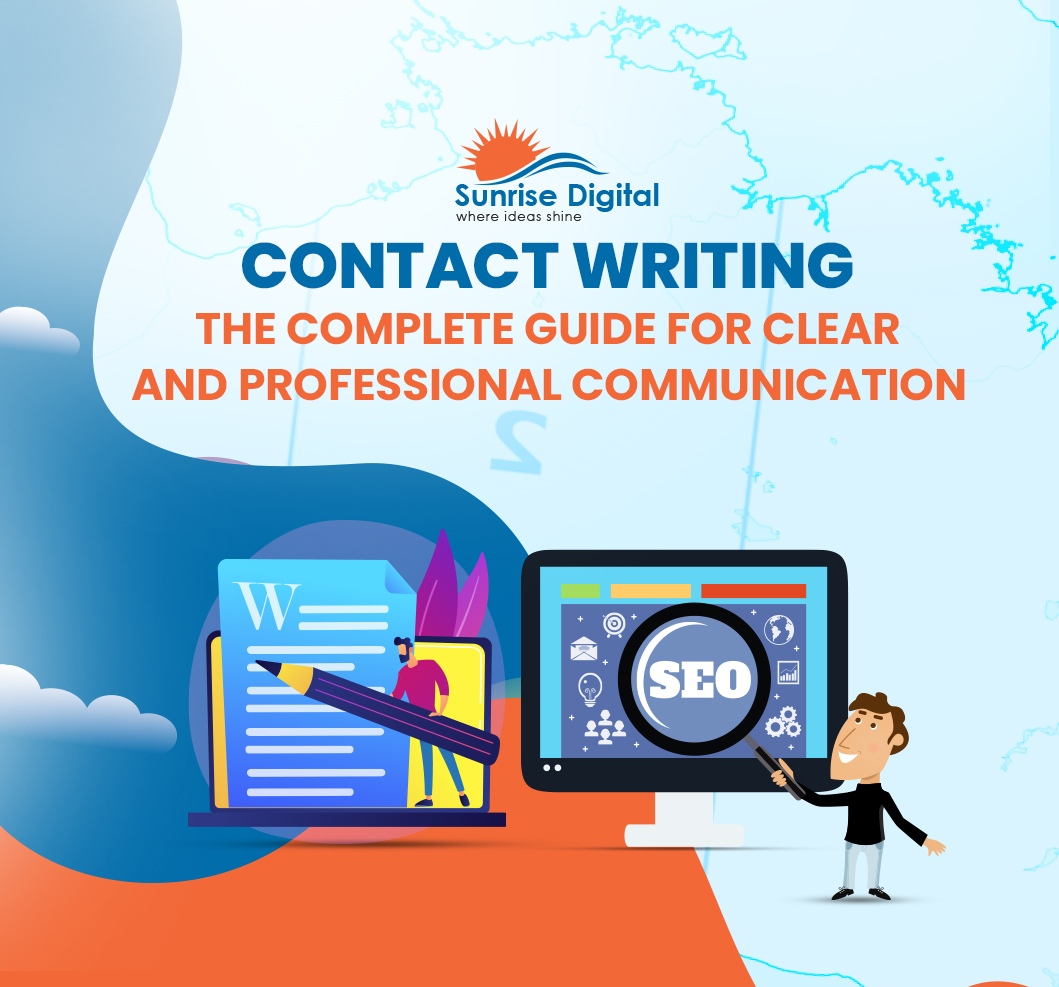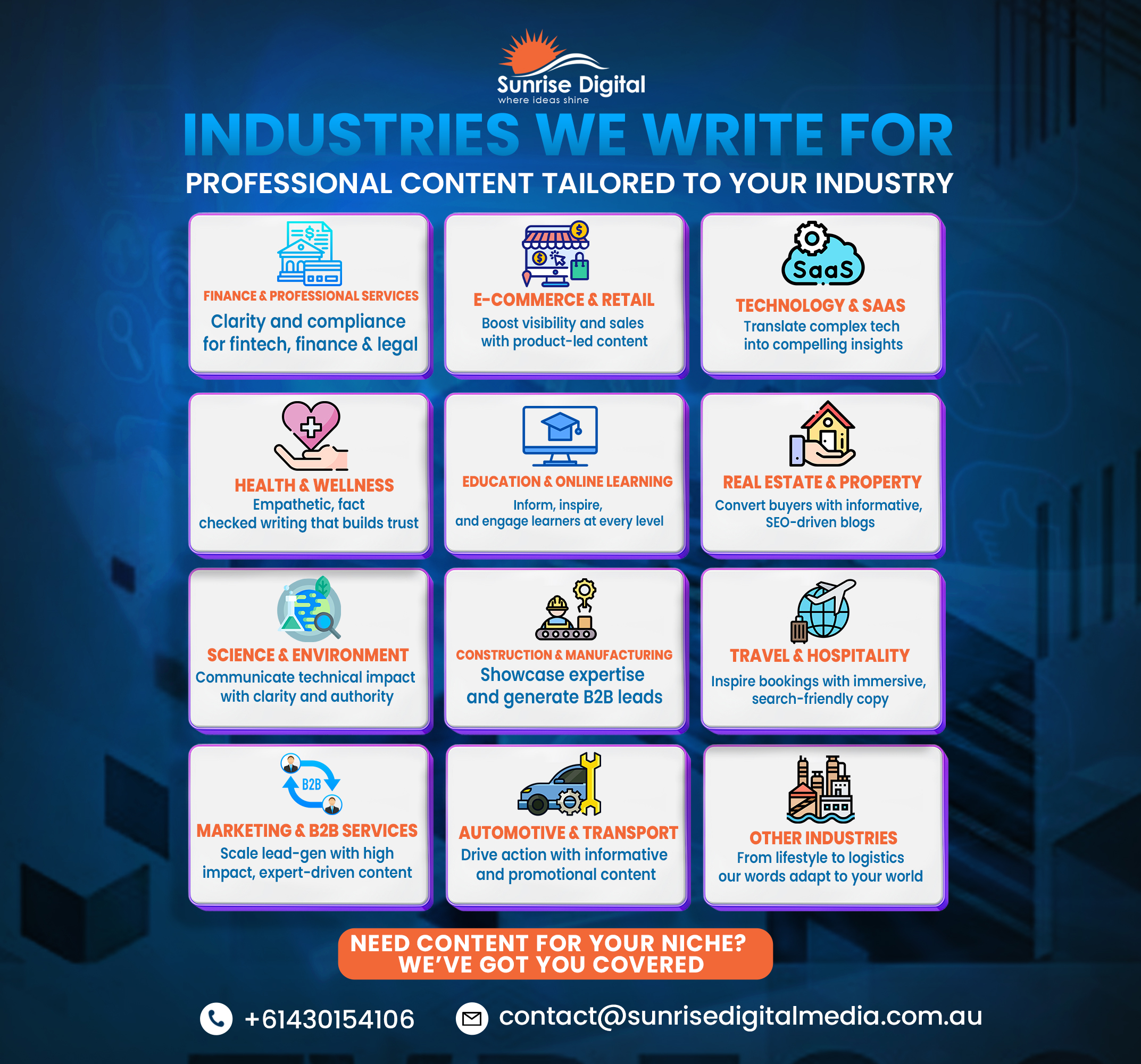Every day in Australia, people send emails, update resumes, and create “contact us” pages that shape first impressions. Yet many don’t realise how much these simple tasks rely on contact writing. Done well, it makes your message clear, professional, and persuasive. Done poorly, it leaves confusion or even missed opportunities.
Think about the last time you emailed a recruiter without a contact name or tried writing a cover letter with no contact person listed. That small detail can make or break the response. This is where contact writing skills matter most.
In this guide, you’ll learn exactly what contact writing means, why it’s essential for business and career growth, and how to apply it to everyday communication. If you’d prefer expert help, our team at Sunrise Digital Media offers professional content writing services trusted by Australian businesses.
What Is Contact Writing?
Contact writing is the skill of putting your information or message in a way that others can understand quickly and act on easily. It covers everything from writing a cold contact cover letter to creating a simple “contact us” page on a website. At its core, it’s about clarity, tone, and structure.
For example, when you write contact information in an email, you don’t just add a phone number. You make sure it’s easy to find, professional, and fits the purpose of the message. The same goes for resumes, where knowing how to write a contact number correctly helps employers reach you without confusion.
Contact writing also applies to networking. Sending an email to connect two contacts or crafting a polite line like “feel free to contact me” shows respect and professionalism. Each small detail helps build trust.
In Australia, strong contact writing skills are highly valued in business and career settings. If you’d like tailored support, our content writer services can help you present your information in the most effective way.
Why Is Contact Writing Important?
Contact writing matters because it’s often the first step in building trust. Whether you’re applying for a job, creating a business profile, or setting up a contact us page, the way you present your details shapes how others see you. Clear contact writing tells people you’re professional and approachable.
In job applications, it can mean the difference between a response and silence. Imagine writing a cover letter without a contact name. Without the right approach, your effort might never reach the right person. Adding accurate contact details to a resume or email makes it simple for employers to connect with you.
Businesses also rely on contact writing. A contact us page that only lists a phone number leaves customers frustrated. Including email, address, and a clear invitation to get in touch improves responses.
Across Australia, effective contact writing is part of good communication. If you want to ensure every message sounds professional, our writing support services at Sunrise Digital Media can help you craft the right words for the right audience.
Core Principles of Contact Writing
Good contact writing follows three principles: clarity, tone, and structure. Each makes your message easier to read and more effective.
📍Clarity and Concise
Clear writing saves time for the reader. In contact writing, this means keeping sentences short and direct. Instead of long explanations, provide the details people actually need. For example, when you write contact information in an email, include your full name, phone number, and job title without extra wording. This ensures your details are easy to scan and remember.
📍Tone and Audience Awareness
Tone shapes how your message feels. A formal tone works well in a cover letter without a contact name, while a friendly style fits a “contact us” page. Think about who will read your message. Adjust your words so they sound natural to them. Even a simple phrase like “please feel free to contact me” can create a polite and approachable impression when used at the right time.
📍Structure and Format Essentials
The way information is organised matters as much as the words themselves. Contact writing should follow a clear order: greeting, message, and sign-off. For websites, structure your contact us page so visitors see the key details first, such as email or phone number, followed by a form. In resumes or applications, place your contact number and email at the top so they’re easy to find.
If you want support refining your tone or structure, our SEO content outline services can help you plan messages that work for every situation.
Types of Contact Writing
Contact writing appears in many everyday situations. Each type has its own purpose, but all share the same need for clarity and professionalism.
✔️ Cold Contact Cover Letters
A cold contact cover letter introduces you to an employer even when there isn’t a job ad. Knowing how to write a cold contact cover letter helps you stand out. Use a clear opening, explain your skills, and show how you can add value.
✔️ No Contact Letters
Sometimes a letter is written to create distance. A no-contact letter should be polite yet firm. Keeping the tone respectful ensures the message is understood without creating conflict.
✔️ Contact Details in Resumes
Employers want to reach you easily. Learning how to write a contact number in a resume means placing your phone, email, and LinkedIn profile at the top of the page. This makes it simple for hiring managers to connect with you.
✔️ Contact Us Pages
Websites rely on contact writing too. What to write in a contact us page depends on your business. At a minimum, include phone, email, and location. Adding a form makes it easy for visitors to send quick messages.
Contact writing may look simple, but getting these small details right improves responses. Our team at Sunrise Digital Media helps Australian businesses create contact pages and letters that actually work.
Step-by-Step Contact Writing Process
Writing becomes easier when you follow a simple process. These steps can be applied whether you’re drafting an email, preparing a resume, or building a contact us page.
Step 1 – Research Your Recipient
Before you start writing, learn who will read your message. If you’re unsure of a name, address the letter to “Hiring Manager” or “Recruitment Team.” This works well when writing a cover letter without a contact name.
Step 2 – Define Your Purpose
Every piece of contact writing should have a goal. Are you trying to connect with a potential employer, share your details, or encourage a customer to get in touch? Knowing the purpose keeps your message focused.
Step 3 – Draft the Message
Write the first version without worrying too much about perfection. Include key details like name, role, and phone number. When you write contact information in an email, place it at the end of the message with your signature so it looks professional.
Step 4 – Review Tone and Structure
Check that your tone matches the audience. A networking contact email should sound polite and open, while a no-contact letter needs to stay respectful but firm.
Step 5 – Proofread and Format
Finally, review for grammar and layout. Make sure details like contact numbers are correct. If it’s a web page, ensure the contact us section highlights key information at the top.
👉 If you’d like expert guidance, our content writing services provide structured support to help Australians communicate with clarity and confidence.
Best Practices and Common Mistakes with Ready-to-Use Templates of Contact Writing
Strong contact writing is built on simple habits. Following best practices improves response rates, while avoiding common mistakes prevents confusion.
✅ Best Practices
Always start with clarity. Use short sentences and direct words so the reader can understand your message straight away. Proofread every line to ensure your contact number or email is correct. A single typo can cost you a reply.
Match your tone to the situation. In a cover letter without a contact name, keep it formal and respectful. In a website’s contact us page, be approachable and welcoming. Phrases like “please feel free to contact me” work well in emails, but should always be placed at the end with your signature.
Finally, structure your message so the most important details appear first. Employers should see your contact details at the top of a resume. Customers should see your email or phone number at the start of the Contact Us page.
❌ Common Mistakes
Long paragraphs, overuse of jargon, or forgetting to include a call to action are common errors. Another mistake is being too casual in a no-contact letter, which can send the wrong signal.
When in doubt, keep it clear, concise, and professional. For more tailored advice, Sunrise Digital Media offers content and SEO services to make your communication effective and search-friendly.
👌 Templates and Examples of Contact Writing
Examples make contact writing easier to understand. Here are a few simple templates that show how to use tone, structure, and clarity.
📌 Cold Contact Cover Letter Example
Dear Hiring Manager,
I am reaching out to express my interest in joining your team. My experience in [industry/skill] allows me to bring value to your organisation. I would be glad to discuss how my background matches your needs.
Kind regards,
[Full Name]
[Phone Number]
[Email Address]
This short format works well when you don’t know the contact person. It highlights skills while keeping the tone professional.
📌 Contact Information in an Email
At the end of your message, add:
Full Name
Job Title
Phone Number
Email Address
You can also close with a polite line such as “Please feel free to contact me if you need further details.” This keeps the invitation open without sounding pushy.
📌 Contact Us Page Essentials
Every website should clearly show how to connect. What to write in a contact us page includes business email, phone, and location. Adding a contact form makes it easy for visitors to send questions at any time.
For businesses in Australia, our team at Sunrise Digital can design and optimise contact pages so they not only look good but also rank well on Google.
Ready to Improve Your Contact Writing? Start Here
Contact writing is more than sharing details. It’s about clarity, tone, and structure that make every message count. Whether you’re writing a cold contact cover letter, updating your resume, or planning what to write in a contact us page, small choices shape the way others respond.
Strong contact writing opens doors in careers and strengthens customer trust in business. Using the right format and tone ensures your words connect with the people who matter most.
If you’d like expert help, Sunrise Digital Media is here to guide you. Our team offers blog content writing, SEO services, and free local SEO audits to ensure your communication and your website both perform at their best.
👉 Take the next step today. Improve your contact writing, and let your message be clear, professional, and unforgettable.
Frequently Asked Questions about Contact Writing
Contact writing means creating clear, professional messages that make it easy for others to reach you. It includes emails, cover letters, resumes, and contact us pages. The goal is to share details like your name, phone, or email in a way that’s easy to read and encourages a quick response.
Place your contact details at the end of the email under your signature. Add your full name, job title, phone number, and email address. Keep it simple and professional so the reader can find your details without scrolling back through your message.
A good contact us page includes your business phone, email, and office address. Add a short line that invites people to get in touch. Many businesses also use a form so visitors can send questions directly from the website.
When no name is listed, use a greeting like “Dear Hiring Manager” or “Dear Recruitment Team.” Keep your tone formal and focused on skills. This ensures your cover letter stays professional and reaches the right person, even without a specific contact name.
Close politely with a phrase such as “Please feel free to contact me if you need further details.” Follow this with your name and signature. This approach keeps the tone friendly while making it clear you welcome a reply.
A no-contact letter should be short, polite, and firm. Start with a clear statement of your intention to end communication, then explain briefly why. Keep the tone respectful and avoid emotional language. End with a line that closes the matter, such as “I kindly request no further contact.”
Place your phone number at the top of the resume with your name and email. Use an Australian format with the area code if needed. Write it without special characters or unnecessary words, for example: 0412 345 678. This makes it easy for employers to dial directly.
Start with a friendly greeting, remind them how you met, and state the purpose of your message. Keep your request simple, such as asking for advice or an introduction. Always thank them for their time, and include your contact information at the end for easy follow-up.
In forms like passports or applications, write the full name, phone number, and relationship of the person you want to contact in case of emergency. Choose someone reliable who can be reached quickly. Always double-check the details before submitting.
Keep the form short and easy to use. Ask only for the details you need, such as name, email, phone, and message. Place the form high on the page and add a line like “We’ll get back to you within 24 hours.” This builds trust and encourages more people to submit.



